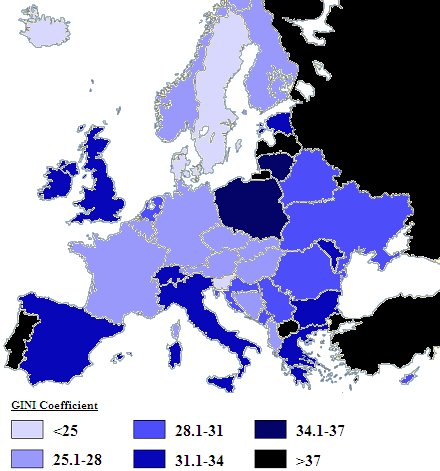The Null Device
Posts matching tags 'gini coefficient'
2010/2/7
An economist from Santa Fe, New Mexico, is questioning the neoliberal economic assumption that economic inequality is the flipside of efficiency. Professor Samuel Bowles, who became interested in the question of inequality at the time of Martin Luther King, claims that economic inequality causes inefficiency, by locking up productive labour as "guard labour", required to protect the wealth of the haves and keep the have-nots compliant and productive:
In a 2007 paper on the subject, he and co-author Arjun Jayadev, an assistant professor at the University of Massachusetts, make an astonishing claim: Roughly 1 in 4 Americans is employed to keep fellow citizens in line and protect private wealth from would-be Robin Hoods.
The job descriptions of guard labor range from “imposing work discipline”—think of the corporate IT spies who keep desk jockeys from slacking off online—to enforcing laws, like the officers in the Santa Fe Police Department paddy wagon parked outside of Walmart.
The greater the inequalities in a society, the more guard labor it requires, Bowles finds. This holds true among US states, with relatively unequal states like New Mexico employing a greater share of guard labor than relatively egalitarian states like Wisconsin.While some guard labour will exist even in the most egalitarian of societies, too much guard labour sustains "illegitimate inequalities", and unproductively locks up units of labour which could, in a more equal society, be employed more productively. And an excess of guard labour also continues inequality, by allowing the creation of a "working poor" compelled by economic necessity to accept unfavourable working conditions, a segment of the workforce it is difficult to elevate oneself (or one's children) out of.
2009/4/20
The Map Scroll blog has a map of the Gini coefficients of all the US states, and another one of Europe.
The Gini coefficient is a number from 0 to 1 representing the equality or inequality of income distribution in an economy; 0 is theoretical absolute equality, and 1 is one person having everything and everyone going without. In practice, it varies from about 0.2 to about 0.7.
According to it, Europe ranges from the mid-.20s to the high .30s, with a few outliers in the low 40s. At the most egalitarian end, unsurprisingly, are the Jante states of Denmark and Sweden, as well as Iceland (perhaps surprisingly, if it's meant to have been an experiment in cut-throat neoliberalism). Things get more inequitous into Norway, Finland, France, Germany and Switzerland (which stays under .28, despite being home to a lot of the global super-rich), and then on to Italy, Spain, Britain and Ireland, and beyond that, Poland and Lithuania. The most unequal country in Europe is Turkey, which has a Gini coefficient of 0.436, somewhere between Guyana and Nigeria, or, if you prefer, Delaware and Hawaii.
The United States is, unsurprisingly, a lot less egalitarian in income than Europe. American states' Gini coefficients range from 0.41 (the solidly Mormon state of Utah, whose state emblem is the beehive, has a Gini coefficient equivalent to Russia's) to a whopping 0.537 in the District of Columbia (comparable to the Honduras). Other states are twinned with parts of the developing world; Alabama and Mississippi are most like Nepal, California has the income distribution of Rwanda, and New York, barely under the .5 mark, is twinned with Costa Rica. According to the article, this is an astonishing state of affairs for a developed country:
According the the CIA World Factbook (table compiled here), the lowest Gini score in the world is Sweden's, at .23, followed by Denmark and Slovenia at .24. The next 20 countries are all in either Western Europe or the former Communist bloc of Eastern Europe. The EU as a whole is at .307. Russia has the highest number in Europe (.41); Portugal is the highest in Western Europe (.38). Japan is at .381; Australia is .352; Canada is .321.
And then there is the United States, sandwiched between Cote d'Ivoire and Uruguay at .450. Not counting Hong Kong (.523), the US is a complete loner among developed countries. In fact, as you can see from the map above, there is no overlap between any single US state and any other developed country; no state is within the normal range of income distribution in the rest of the developed world. Here's a list of the states with their Gini index numbers, and the country where income distribution is most comparable in parentheses:Other interesting maps on the site include a map of religious nonbelief in the UK (which points out that Scotland and Northern Ireland are the most religious, and asks whether that correlates to the Scots-Irish roots of the US "Bible belt"), of antidepressant use in England and Wales (summary: it's grim up north, and in Cornwall too; either that or Londoners prefer a line of coke), and one suggesting that, as global warming advances, Australia is ecologically fux0red.
